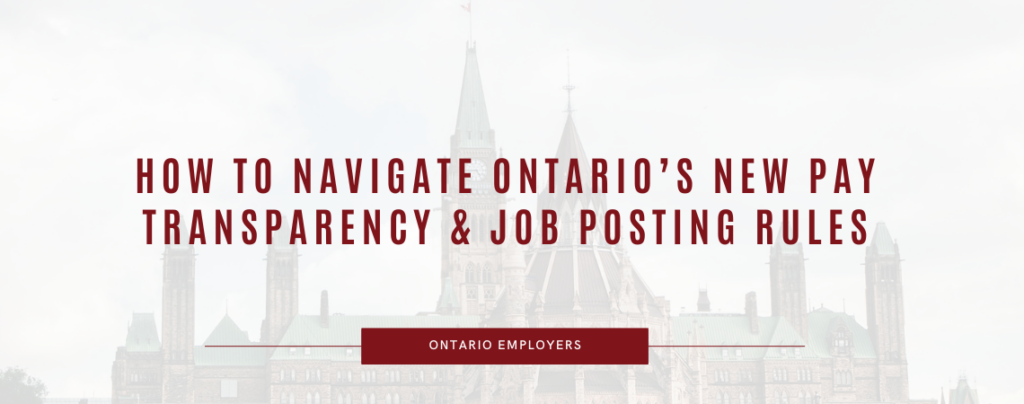
In effort to make the workplace more equitable and transparent, the Ontario government is rolling out new regulations regarding pay transparency and job posting practices.
What does this mean for Ontario employers?
These changes are part of the Employment Standards Act and will impact Ontario employers, particularly those with 25+ employees. You’ll need to update your processes and documentation (if you haven’t already).
Here’s what you need to know in advance of January 1, 2026.
What’s Changing and When?
Already in Effect as of July 1st, 2025: New Requirements for Employers
Ontario employers with 25+ employees will need to provide specific information to their employees before their first day of work or as soon as reasonably possible after the employee’s first day of work.
These requirements include:
- Business Information: Employers must provide their legal business name, any other business names used, and contact details like address, phone number, and contact persons.
- Work Location: While the exact details might evolve, employers need to provide a general idea of where employees will be working.
- Wages and Pay: Employers will need to specify the starting wage, including hourly rates, salaries, commissions, or any other forms of pay.
- Pay Schedule: The pay period (weekly, bi-weekly, monthly) and payday details must be shared with employees.
- Work Hours: Employers must outline the expected work hours, giving a general idea of the employee’s schedule.
These measures aim to improve transparency and ensure that employees are well-informed about their roles from day one.
Effective January 1st, 2026: Significant Changes for Job Postings
In addition to the requirements for existing employees, Ontario employers will also face new obligations when it comes to job postings. The goal is to ensure that hiring practices are fair and clear to all potential applicants.
Here are the key changes that will affect job advertisements:
- Salary Range Transparency: Employers will be required to provide a transparent range of wages or salaries for open positions in any publicly advertised job posting. For roles where the expected pay is less than $200,000 annually, the compensation range must be within $50,000. This aims to reduce salary discrepancies and foster fairer compensation practices.
- Artificial Intelligence (AI) Disclosure: If AI tools are used to screen, assess, or select candidates, this must be disclosed in the job posting. Transparency around AI’s role in the hiring process will be crucial for building trust with candidates.
- Vacancy Status: Job postings must clearly state whether the role is for an existing vacancy or a new position. This helps applicants understand whether the job is an immediate need, or a role created for future planning.
- Canadian Work Experience: Employers will no longer be allowed to require Canadian work experience in job postings or associated application forms. This will help open opportunities for immigrants and international talent, making it easier for them to apply.
- Hiring Decision Notification: Employers must inform candidates whether a hiring decision has been made within 45 days of the interview. This change aims to improve candidate experience by providing timely feedback.
- Retention of Records: Employers will be required to retain records of job postings and interview information for at least three years. This includes keeping copies of all job postings, application forms, and interview notes.
Preparing for a More Transparent Future
The new changes to the Employment Standards Act are all about fostering fairness and transparency in Ontario workplaces – and it’s exciting to see these positive shifts! We expect more provinces to follow suit as pay transparency and AI legislation continue to gain traction across the country for Canadian employers.
While we won’t feel the full impact of these changes until 2026, there’s no time like the present to start preparing. For HR professionals, this means getting ahead of the game by updating your processes, reviewing your hiring practices, and being ready to share more detailed information with your current and future team members.
By staying on top of these changes, you’ll not only keep your organization compliant but also create a more open, fair, and inclusive work culture that everyone will appreciate!
Questions about next steps? Download our free summary for additional details and tips to navigate these changes compliantly.
(This post was updated on November 3, 2025 to reflect up-to-date information.)